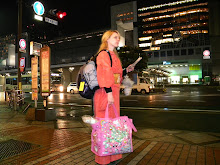
"Don't eat the radish!" my neighbor whispered fiercely to me, a slight murmur that delicately broke the air as we ate breakfast in silence at the Bubheungsa Temple in Gangwon-do.
"I wasn't going to eat the radish," I hissed back, which earned a stern look of disapproval from the Korean-to-English translator. The monk in charge kindly pretended not to hear.
The monastic breakfast was a complicated procedure, and intense considering it was meant to replicate simplicity and man's commune with the farmers and fields that created it. First, we quietly arranged the set of bowls and utensils we'd been given. I unfolded the brown place cloth and laid it in front of the thin mat on which I sat, cross-legged. Next, I carefully arranged the four bowls. The rice bowl I placed at the front left, next to the soup bowl. The side foods bowl belonged directly behind the rice bowl, and across from it was the rinsing bowl.
Small portions of the food were then ladled by servers into our bowls. Next, the communal bowls of food were passed around a second time, where we could take a second serving if we were so inclined. However, we had to be very careful not to take more food than we could eat. In order to honor the farmers and spice harvesters, we were bidden not to leave a single grain of rice in our bowl, not even a speck of spice was to be wasted.
Even the actual process of eating was something of an art. To eat in a polite and proper manner, we were to hold a bowl with our left hand and tip it upwards so that our mouth was modestly covered the entire time. Our right hands held the wooden chopsticks to bring the food into our mouths. Because of this, our breakfast took a while to consume -- nearly two hours. For some people, such as myself, it was difficult enough to eat using chopsticks, much less while hiding my face and scooping out every speck of food.
It was not until every white grain of rain, every red flake of spice had been consumed that we could wash our bowls with the drinking water and scrub them clean with the bright yellow slice of pickled radish. Following that, we drank the water and then, finally, ate the radish. It was a very neat way of doing the dishes. To prove we'd sufficiently cleaned our plates, our bowls were rinsed a second time with water which was dumped into a large bucket. If the communal rinsing water was tainted by anything - even a single flake of spice - we were to take turns drinking the dirty rinsing water until the bucket was empty.
Eating was only one element of the weekend I spent at the Bubheungsa Temple. Another basic necessity of life also treated differently was attire. Upon arrival at the temple, we exchanged our worldly clothes for outfits traditionally worn by practitioners of Buddhism. The deep-pocketed vest and balloon-like pants were cut in a slouchy fit, so that the vanities and temptations of our bodies were hidden beneath their loose folds. Though unfashionable, they were made of soft linen and were some of the more comfortable items of clothing I'd ever worn. They were died a natural terra cotta colour, like soft dirt, and a Korean man (not part of the group) told me this signified the colour of earth dying. I'm not sure what that means, but it sounded somewhat poetic.

Other spiritual elements, such as meditation, were also part of the temple stay experience. On Saturday, the group of temple stay participants gathered together to take a meditative walk through the woods. The monk bid us to think only about the physical process of walking. So, I slowly placed one bare foot in front of another in the velvety-soft dirt path, focusing on nothing more than the wind and my breath, which did not seem so very different. As there was a rather large group of participants in the meditative walk, we attempted to keep a certain pace and distance between us. Dressed in our faded, matching clothes, we solemnly marched through the woods in pairs, like a raggedy wedding party.
A different sort of practice that was taught and then practiced throughout the temple stay was full-body prostration. While spending time in the temple buildings, dedicated Buddhists, as well as temple stay participants, bowed their entire bodies low until their foreheads touched the ground, and then leaned back somewhat upright on their heels. They repeated these deep prostrations sometimes upwards of 100 times in a row. Whenever I entered a temple, I bowed my head briefly to show respect for the Buddhists and their way of life; however, I refrained from making the full-body prostrations because they conflict with my Christian faith. Most participants viewed the temple stay as a "culture vacation," but gods are gods, and I wasn't about to mess with them.
Since I skipped the many prostration sessions, I ended up several hours alone each day. During early Sunday morning, I took a walk by myself through the woods and into the clearing between several mountains. I was not pondering deep, reverent thoughts, nor was I attempting find my inner peace. I just wanted to have fun and take photos. I was so happy in the sweet, piney air and the breeze that lightly ruffled my hair that I nearly skipped along the path. I took some pictures. I sorted through coloured rocks and sprays of wildflowers, discerning which to leave and which to keep. I looked up at one of the tallest mountains and saw the outline of a big cat -- A tiger! I thought -- in the rockface there. I spun about with the dizzy happiness that only inner content can bring. My irreverent, happy-go-lucky attitude is what makes what happened next so inexplicable: A raw, eerie energy swept through the mountain. It was such a strange experience that I can barely describe it, and certainly not compare it in any normal analogy. The best I can do is say it felt like I was seeing a ghost, only nothing was visible. Nothing in the landscape had changed, only this feeling, only an energy.

At first, I was frightened and almost ran out of the forest, back to the safe and well-populated temple buildings, but then I refused to turn coward. How could I explain this to anyone in a logical manner? How could I possibly describe why I'd run away -- because I was afraid of the air? So I stayed and decided I would finish what I'd set out to do: walk along the trail and take pretty pictures. I set my camera on auto mode and, several times, tried to photograph myself against the dramatic backdrop of towering green mountains. The photos did not turn out; they were all over-exposed, tainting the scene with a lemony-white cast like a halo around the mountains. And here's a detail that makes the over-exposed photos inexplicable: The day was overcast. Shifting through clouds and shadows, from where did all that light come? When I returned to the monastery, I gave a brief version of my experience to the translator. He was not at all surprised; that area was renown for its energy field. And the tiger I saw on the face of a mountain? For hundreds of years, monks have identified it as "Lion Mountain."
At night, the only light came from the stars overhead and the lanterns that hung throughout the temple grounds. There was a line of lanterns in all sorts of colours -- pink, orange, red, yellow, and blue -- marking the pathway from the lower temples to the highest one, and there were multiple strands of lanterns festooned in front of the oldest temple. Some of the lanterns had the image of Buddha peeping merrily out from a lotus and some had images of the temple imposed on them, while other lanterns bore the cartoonish representation of a lion. I felt (probably impiously) they gave the temple a festive air.

The temple stay's main focus seemed to be the "wish fulfillment" program. I am dubious as to how much a serious application of Buddhism includes wish fulfillment and how much the idea was spun into an appealing romantic-religious ideal for Western visitors. For Disneyfied as it may seem, who does not want to believe that wishes can come true? Throughout my life, I've wished on loose eyelashes, falling stars, dandelion fluff, birthday candles, the times 11:11 and 1:11, and reluctant ladybugs waiting for release. As it turns out, all I really needed to do was write my dearest desire on a slip of paper, place it inside a small cloth pouch, and hang the pouch in a temple. Oh, and hit an old bell! A very important, or at least very fun, part of the wish fulfillment was to lift a wooden gong and swing it with considerable relish against an ancient, sacred bell while simultaneously making a wish.

Of course, I was tempted to wish that everyone thoroughly clean their breakfast bowls the next morning so that I would not have to drink the dirty water, but that seemed a rather short-term investment for a wish. In my heart-of-hearts, I've really only ever believed two things were worth wishing for: true love and adventure. The only problem is that I've already wasted enough wishes on falling stars for a true love that's never arrived. And adventure is something I'm creating for myself. So, since neither of those two stand-by wishes would do, I returned to an even older wish, one that I remember whispering to a reluctant ladybug when I was seven years old: I want to be a writer. I want to be a good writer and earn a sustainable living from it.
God only knows if my wish will come true.




Unless it’s Theravada Buddhism, I think the prostration is only meditation, centering, and/or reinforcement of humility. It is the concentration on ritual practice to purify the mind. The teachers from the Zen Buddhist temple class on meditation in A2 explained it as different practices will help different people meditate better than others, so we were exposed to several.
ReplyDeleteSome people find it more effective due to the symbolism than others. It seems that finding symbolism an action is an attachment and that all actions done with right intent and concentration can be equally purifying.
As for camera metering, I think it will favor its point of focus. So if focused on something darker it may over expose, or v.v..
It looks and sounds like a great experience, though. Where was this mountain with the energy?
best,
m